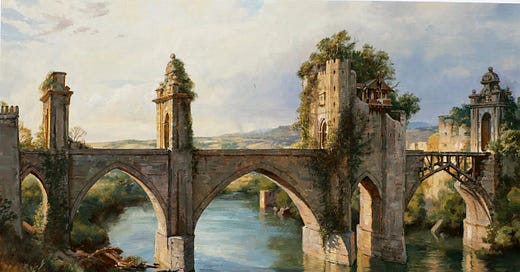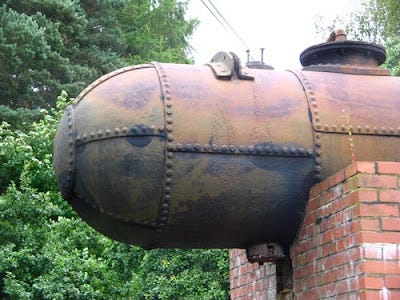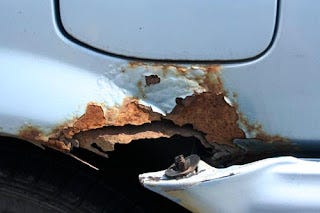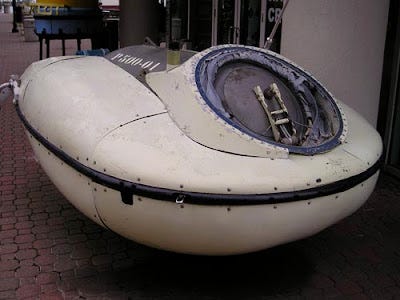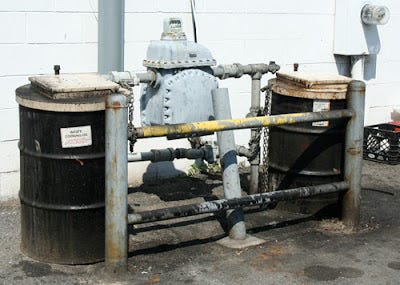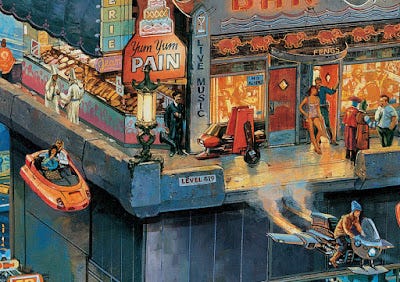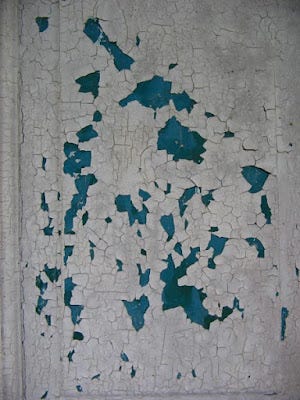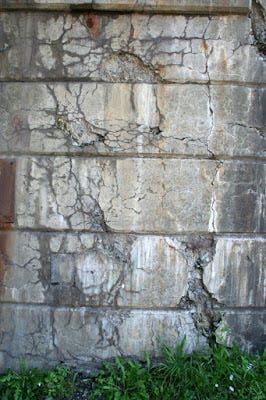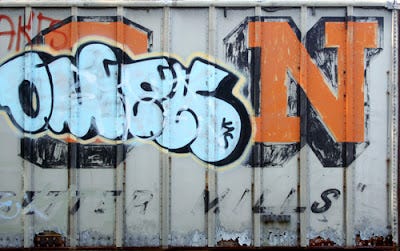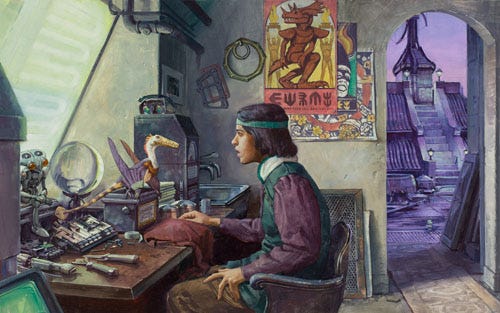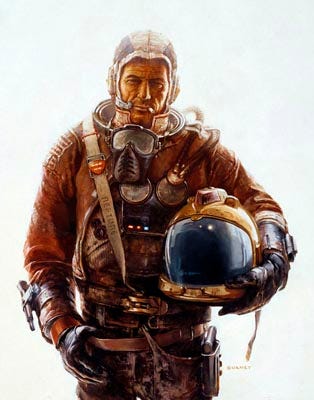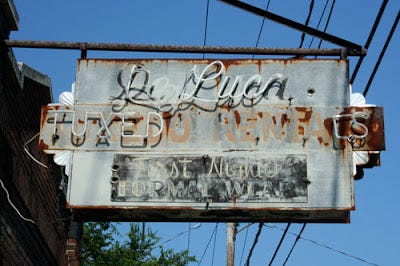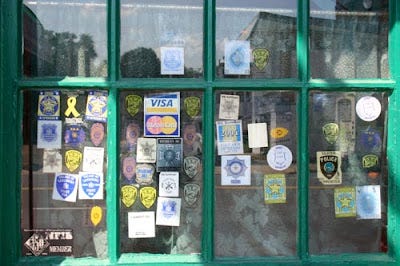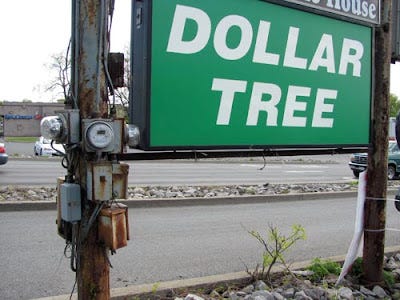As we saw in Monday’s post, if we want our images to suggest a backstory, we need to give the viewer a lot of little visual clues to help them understand the context of the image. Those clues can hint at what might have happened before in the scene or what might be happening offscreen.
For example in this painting of a ruined bridge in Dinotopia: Journey to Chandara, it’s clear the civilization is in some decline, as the tower is in ruins, but someone has built a wood structure and the old stone bridge has been repaired with wood for light traffic.
This post is a checklist for things to keep in mind if you want to make your world appear lived in. I went around and took some photos and found some samples to suggest the kinds of effects we're talking about.
1. VEHICLE MAINTENANCE
Instead of always showing imaginary vehicles in perfect repair, why not show them in the shop? Most train yards have a side track for discontinued designs or ones in need of repair. Who does the repair? Where does it happen? Does some authority have to sign off on getting a repair OK’ed?
2. FACTORY FINISH
In both digital and painted renderings, surfaces usually come out looking pristine and new, so adding wear and tear takes deliberate effort. Leave some parts of it looking almost perfect, and then add dirt, dust, cracks, chips, creases and bent corners to the parts that get the most handling or exposure to the elements.
3. CORROSION
Most metals except gold corrode when exposed to air or water. Corrosion is a chemical reaction where the metal combines with oxygen. Each kind of metal has a characteristic color. Iron corrodes to a red-orange, copper to a dark brown or green, bronze to a blue green, and aluminum to a white powder. Thin outer surfaces corrode first, especially if they’re exposed to salt. A colored stain often stains downward following the path of water runoff.
4. DENTS AND SCRATCHES
The dents and scratches in a vehicle tell the story of a series of misfortunes. Traffic impacts are often at bumper height; aircraft often get nicks on the leading edge of the fuselage and wings. Industrial designers usually plan for breakable forms like light covers and windows to be set back from the outermost edge of the form. The Cousteau submersible vehicle above has a scratches, dents and paint chips missing from its many voyages.
5. STREET TRAFFIC WEAR
Vehicles also wear down the surfaces they contact in very particular ways. Asphalt surfaces are prone to potholes and lateral cracks, as well as indentations under the wheels from the weight of heavy vehicles, especially at intersections. You can imply the passage of large vehicles by putting scrape marks under bridges or guard bars around delicate forms (such as those guarding the cooking oil barrels behind this fast food restaurant).
Detail of Spaceport Bar by James Gurney from Imaginative Realism
6. FLYING VEHICLE WEAR
Airport tarmacs have skid marks from tires on touchdown. Spacecraft would probably need some sort of launch apparatus, which would endure abuse from the propellants. Large spacecraft in docking bays might use some kind of flexible fenders like those that shield docks from ship impacts.
7. PAINT CHIPS
Paint doesn’t adhere well to sharp edges or corners, so it chips off there first. Nor does it hold on if water vapor gets trapped underneath, so it will often peel at the base of a wall near the ground. Paint will crack with a particular geometry, with the cracks usually meeting at right angles.
8. CRACKS
Rigid materials bend a certain distance before they break. Brittle materials, like masonry or cement, will crack in lines perpendicular to the direction of expansion or bending. Pre-scoring sidewalks reduces cracking. Trees push up on paving surfaces around their root systems. This kind of cracking and heaving is accelerated in subfreezing weather. Window glass tends to crack in radiating lines from the point of impact.
9. VANDALISM AND GRAFFITI
People deface things for a variety of reasons. Pyromaniacs might burn a parked car or an abandoned building. Bored kids might break windows. Many regard graffiti as vandalism, but people often do it in the name of art. A lover might use graffiti as a declaration of love, or a gang member might use it as a proclamation of group identity. In a totalitarian society, protestors often deface the visage of a despotic dictator. Most graffiti has looping or curving shapes because it follows the radius of arm movements.
10. DEBRIS
Small windblown street debris includes such things as paper wrappers, leaves, or cigarette butts. It collects in corners or against curbs wherever there’s no person or machine to actively clean it. Futuristic societies could have robot drones doing the job. Junk debris also collects wherever people leave it: on counters, in stairway landings, or on rooftops. In this scene of a rooftop workshop (above) there are tools and parts on the counter, a dented screen against the wall, and larger machine parts outside.
12. WORN COSTUMES
Old clothing tells the story of the owner’s life. In the case of this asteroid miner, he has evidently worked for a variety of different corporations, including one called “Western,” and has toiled away for a time on Neptune. The American flag on his shoulder is tattered, and his jacket is as creased as his forehead.
12. GRAPHICS
Letterforms can be made from paint, stick-on vinyl, neon, or translucent plastic. You can contrast hand-lettering with machine lettering to suggest a society with an extreme class division. Consider what technology your society will use for changing information, such as announcing that a business is “Open” or “Closed.” You might show the system failing in some way, such as having some of the letters not lighting up.
13. LEAKS AND STAINS
Cooking oil must be vented from a kitchen, and it invariably stains the area around the vent with a black stain that drips downward. All vehicles use lubricants which drip from the engine in places where the vehicle stays stationary or where it hits a bump in the road. Every vehicle needs access points for refueling or lubrication. Drips form below these points.
14. LABELS AND LICENSES
In young societies, there often isn’t much regulation of vehicle traffic or commercial activity. But as a society ages and gets more crowded, vehicle owners have to show that they’ve met legal requirements for registration and inspection. Vehicle labels include license plates, inspection stickers, theft warnings. Because alcohol and drugs are usually regulated, you often see a lot of stickers near the entrances of bars.
15. CONDUIT CLUTTER
To make a dwelling or vehicle receptive to wireless signals, it needs antennas or parabolic dishes. Anything that needs a direct flow of electrons, fluids or light pulses needs wires or pipes or fiber optic cables. In old stone structures, these are often run along the outer walls. Large scale cable corridors typically follow railroad right-of-ways. Obsolete cables, antennas, or satellite dishes are often not removed after they become obsolete.
The final 10 tips explore improvised repairs, clutter, recycled tech, invasive plants, and other ways a scene gains character over time.
Keep reading with a 7-day free trial
Subscribe to Paint Here to keep reading this post and get 7 days of free access to the full post archives.


